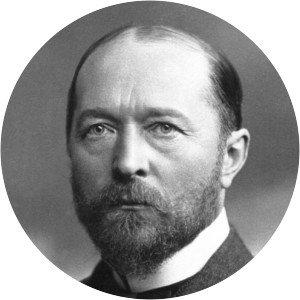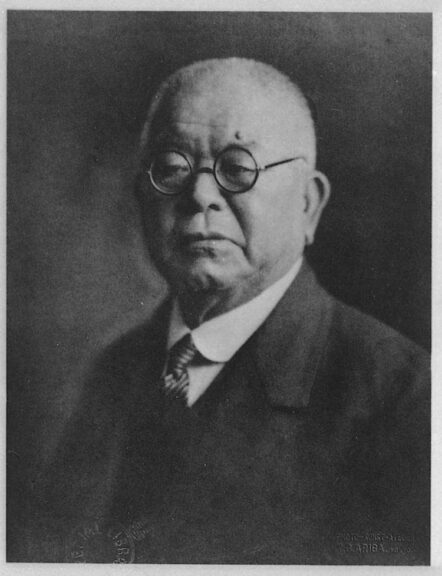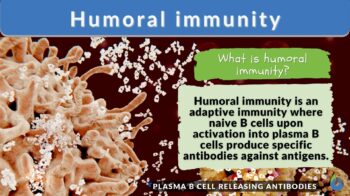
Humoral immunity
n., [ˈhjuːmərəl ɪˈmjuːnəti]
Definition: type of immunity wherein B cells produce antibodies specific to antigens
Table of Contents
Let’s get to know where one should place humoral immunity, the topic of today’s discussion!! By the end of the article, you should be able to answer some of the common questions like what is humoral immunity, what humoral immunity involves, differences between innate immunity and humoral immunity, differences between humoral and cellular immunity, what cell-mediated immunity relies upon, etc.
Humoral Immunity Definition
Humoral adaptive immunity is a form of adaptive immunity whereby B-lymphocytes and plasma cells (effector b cells) produce antibodies against foreign agents (antigens) and stimulate T-lymphocytes to attack them. This type of immunity is mediated by antibodies. These antibodies also stimulate the release of chemical mediators (for example interferons, complement proteins, etc) which enhance antigen destruction.
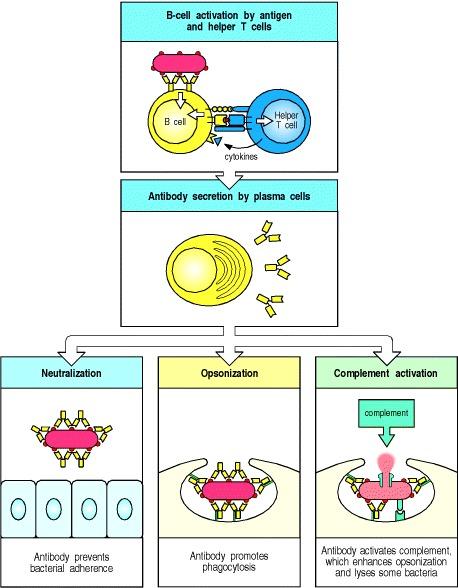
If asked to define humoral immunity, this is how we do it.
What is a humoral response? The reason it’s named humoral immunity or humoral mediated immunity is because of its mechanism of action. Humoral immunity works by a mechanism requiring the substances found in body fluids, i.e. humor.
It’s also called “antibody-mediated immunity” as antibody production is one of the notable features of this immunity development. By its nature, this immunity is “specific” as a specific primary humoral immune response is generated against each particular antigen or foreign material.
The main purpose of this immunity is to protect the extracellular spaces of the body as intracellular pathogens spread from one host cell to another via the extracellular fluids.
As gathered from multiple research studies, extracellular spaces are highly prone to invasion by several pathogenic species. Even intracellular pathogens are known to use the extracellular route when navigating from one cell to another cell.
Hence, it becomes even more important to exploit this chance of evading pathogenic attacks, and the human body knows well to make the most of it.
That’s the reason antibody production in humoral immunity by B cells and then its subsequent secretion plays such a big role in immunity development. Look at the humoral immunity diagram below to learn the basic steps involved.
Humoral Type of Immunity
Immunity and the immune system are highly regarded topics of Science. A huge proportion of the research community, scientists, and medical practitioners across the world are in complete awe of the limitless dimensions of this subject. Not only are they astonished by the elements as complex as they can be, but have dedicated their lifetimes to understanding the “Science of Immunology”.
In Biological Science, we define immunity as the unique capability of all multicellular organisms to stay resilient to any acts of invasion by harmful microorganisms. The characteristic organs, cells, fluids, secretions, and tissues that endow this unique capability onto the multicellular organisms together constitute the immune system of the body. There are a number of ways in which you can categorize immunity to gather knowledge more efficiently. Let’s look at some of the common ways in which you can categorize immunity.
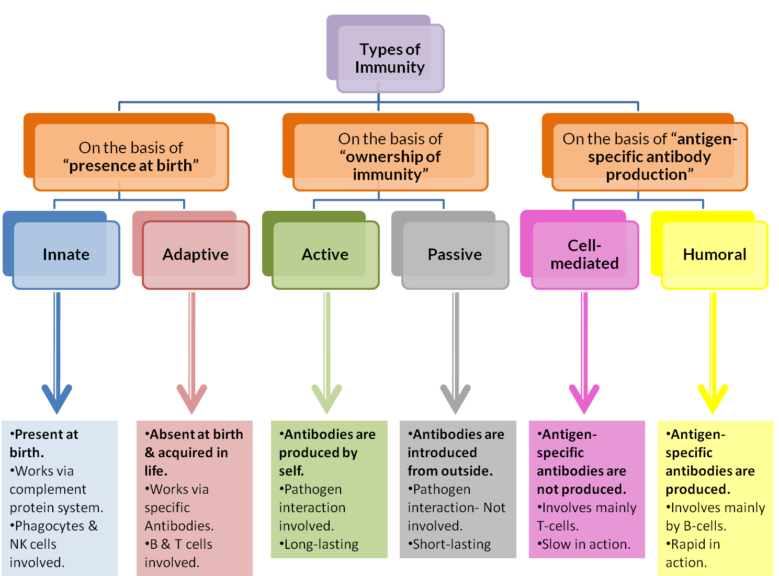
Biology definition:
Humoral immunity is a form of adaptive immunity whereby B-lymphocytes and plasma cells produce antibodies against antigens and stimulate T-lymphocytes to attack them. These antibodies also stimulate the release of chemical mediators (e.g., interferon and complement) that enhance antigen destruction.
Etymology: humoral, from Latin hūmorālis and immunity, from Latin immunitas
See also: immunity, lymphocyte
Differences between “Humoral Immunity” and “Cell-mediated Immunity”
As shown in the flowchart above (Figure 2), humoral vs cell-mediated immunity have stark differences between them. Although when considered in the light of “presence at birth”, both of these immunities are adaptive in nature, meaning both of them develop after birth. (Although, they don’t abide by all the rules to get listed under adaptive immune system).
Let’s list out some of the main differences between cellular and humoral immunity in order to get a clearer outlook.
Differences Between Humoral and Cell-mediated Immunity | ||
|---|---|---|
| Characteristic Feature | Humoral Immunity | Cell-mediated Immunity |
| Antigen-specific antibodies produced | Yes | No |
| Triggered by … | B-cells/B cell lymphocytes | T-cells/T cell lymphocytes |
| Mediation via … | B-cells, T-cells, and Macrophages | Helper T-cells, Cytotoxic T cells, NK cell (killer t cells), and Macrophages |
| Action on/Target | Extraneous or extracellular microorganisms and their toxins | Intracellular microbes (e.g., tumor cells, viruses, bacteria, parasites) |
| Antigen-recognizing cell receptor | BCR receptors (mIgM+mIgD) *NOTE: ‘m’ stands for membranous. | TCR receptors |
| Accessory receptors involved | Igα, Igβ, CD40, CD21, Fe receptors | CD-2,3,4,8,28 & Integrin receptors |
| Antigen processing is needed | No (Unprocessed antigens are recognized.) | Yes (Antigens are 1st processed and then presented by MHC of antigen-presenting cells) |
| Major secretory cells | B-cells | T-cells |
| Major secretion | Antibodies (Antibody-mediated immunity) | Cytokines (signaling proteins) |
| Time of action/Spontaneity | Rapid | Delayed/Slow |
| Action on transplants and tumor cells | No | Yes |
Data Source: Dr. Harpreet Narang of Biology Online
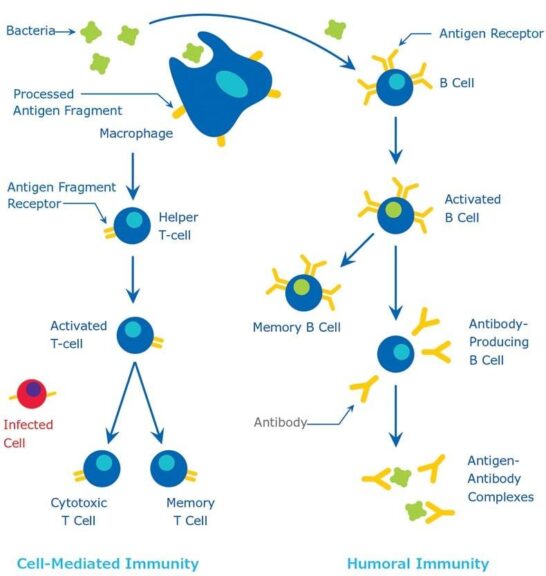
Image Credit: Sigma Aldrich.
History

Figure 4: Hans Buchner was a German physician who proposed the humoral theory concept. Image Credit: Beilage zur Münchener Medizinische Wochenschrift. vol. 49, München: J. F. Lehmann 1902 (link). Concept development of “Humoral Theory” and “Alexins”
The humoral theory concept was developed by Hans Buchner in 1890. It was developed on the basis of ‘serum components study’ that focused on the antibacterial activity of the blood serum. At that time, he credited the “alexins” in the blood serum and body fluids to being protective in nature. By protective, he meant that these components have an in-built capability to kill pathogenic microorganisms.
Concept of “Complements”
The concept of complement proteins was developed by Paul Ehrlich. He redefined alexins as complements. Complements are explained as the soluble subpart of the innate immunological response. The significance of this finding is that complements have a role in both cell-mediated and humoral immune responses. This also leads to the successful bridging of innate and adaptive (acquired) immunity.
Theory development and discovery of antibodies or anti-toxins
Emil von Behring and Kitasato Shibasaburō developed the concept of antitoxin. They worked on the diphtheria-causing bacterium and tetanus-causing bacterium. They found out that the humor/serum starts accumulating antitoxins on exposure to bacterial toxins. This serum can then be used to immunize non-affected and non-immunized individuals.


Figure 5: Emil von Behring along with Kitasato Shibasaburō discovered antibodies. Image Credit: Emil von Behring (left photo) and Kitasato Shibasaburō (right photo). Finding the role of antibodies
Paul Ehrlich found out the role of antibodies against antigens. He stated that antibodies are responsible for immune response development. He worked on the specific antibodies developed by the body against the two plant toxins namely ricin and abrin.
Anti-diphtheria antibody
Paul Ehrlich and Emil von Behring together developed the antitoxin for diphtheria toxin. For recognizing Paul’s contribution to the field, he was awarded the Nobel Prize in Physiology or Medicine in 1908.

Figure 6: Paul Ehrlich contributed immensely to the field of immunology. His contribution to treating diphtheria via transfer of blood serum that carried the anti-toxins or antibodies to the non-immunized individuals was huge. Image Credit: NobelPrize.org.
Antibodies
The concept of antibodies was developed by Emil von Behring and Kitasato Shibasaburō. Antibodies are the immunoglobulins that biochemically constitute glycoproteins. They are a part of the immunoglobulin superfamily. In a general way, these two words — antibody and immunoglobulin-Ig — are used interchangeably.
Since they are responsible for mediating humoral immunity, they are majorly found in body fluids. Their presence is noted in blood, bodily secretions, and tissue fluids.
Therapeutic antibodies are being designed that recognize intracellular target antigens. These could help in mitigating tumor antigens.
Antibody Structure
Antibodies are Y-shaped proteins with four polypeptide chains. By their nature, they are globular proteins. Each of the 4 polypeptides has an NH2 terminal and a C terminal. They have two heavy chains and two light chains. A 100-110 amino acid sequence of the NH2 terminal of all four chains constitutes the CDR (complementarity determining region) or HVR (hypervariable region). The rest of the part is called the framework region (constant region). CDRs of both the heavy and light chains are required for antigen recognition.
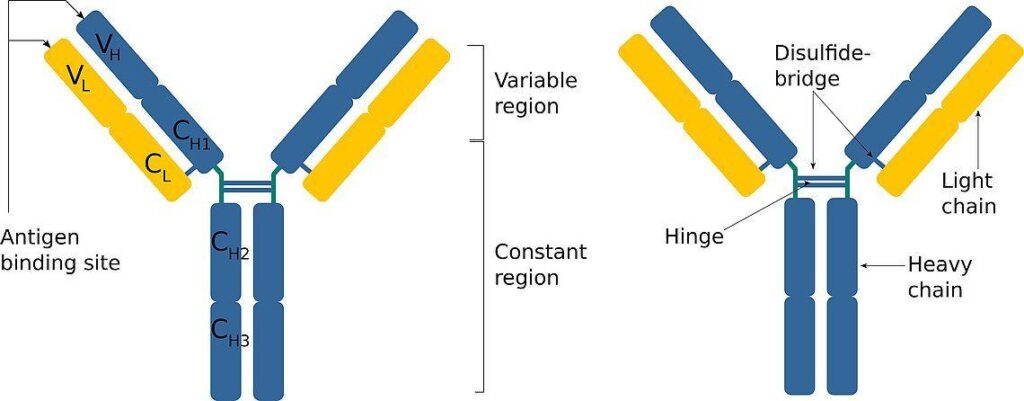
Types of antibodies
On the basis of constant heavy chains, immunoglobulins (Ig) are classified as IgG, IgM, IgA, IgD, and IgE. Each of these Ig has a pre-determined specific role. They have evolved to counter different types of antigens.
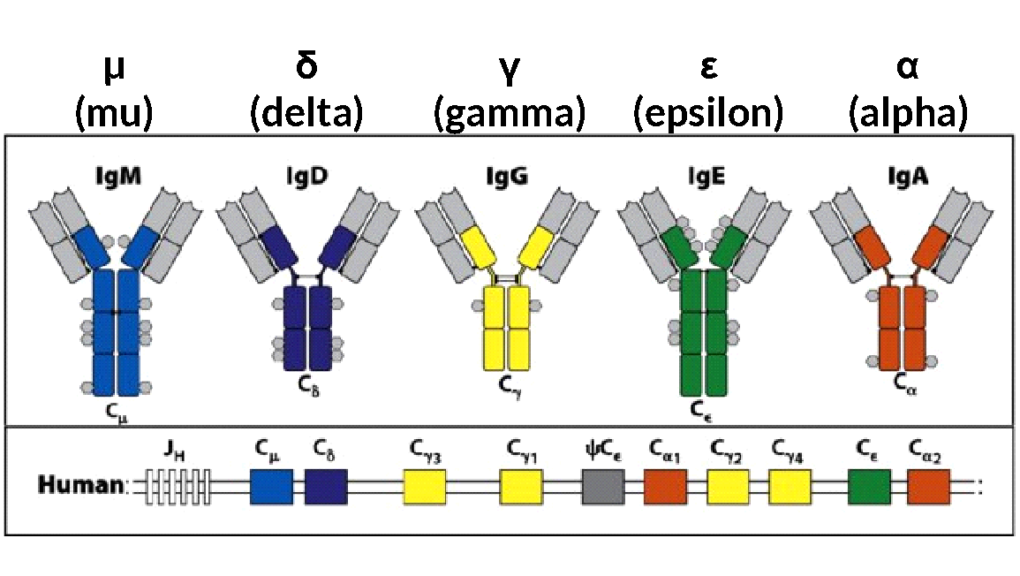
Watch this vid about the different types of immunoglobulins:
Antibody production
Antibodies are produced and secreted by the plasma B cells. Plasma B-cells have characteristic CD-38, CD-79 and CD-138. The first immunoglobulin produced on antigen recognition is IgM.
Role of Antibody in Humoral type of Adaptive or Acquired Immunity
Antibodies play an instrumental role in the acquired immune response. They aid in both the identification of antigens as well as in the generation of a neutralization process against these antigens (neutralizing antibodies). Every antibody is antigen-specific. There are several processes that antibodies mediate:
- Process of agglutination and precipitation by the formation of antibody-antigen products
- Priming step for phagocytosis (Phagocytosis is mediated by macrophages and other phagocytic cells or immune cells)
- Blocking of viral receptors
- Stimulation of other immune responses
- Initiation of the complement pathway
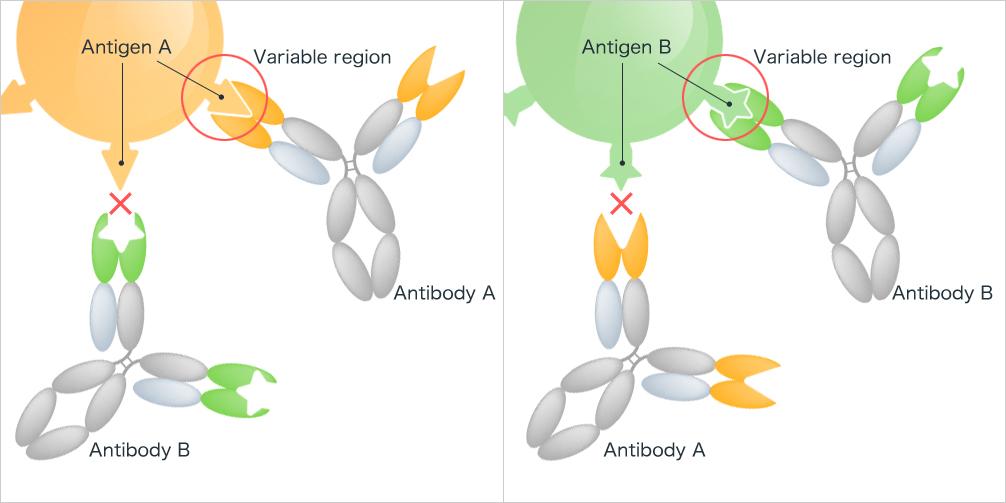
B cell Activation
When an antigen is encountered by a naive B lymphocyte, a signaling cascade starts. The receptors of the naive B lymphocytes are the site where antigen binding takes place. Till this point in time, the antigen is called unprocessed in nature. It is essential for an antigen to be hydrophilic, unprocessed, and free in nature to be acted upon by a naive B lymphocyte. From here, there are two different pathways for B lymphocyte activation.
- Helper T cell-independent pathway
- Helper T cell-dependent pathway
Both of these pathways eventually lead to B-cell activation.
- Helper T cell-independent pathway:
- In the process, B-cells gain B-cell receptors (BCRs). BCRs are displayed on the cell surface. BCRs recognize microbial associated antigens.
- When these naive B-cells encounter a ‘carbohydrate or lipid form of antigen’, the antigen comes in contact with the B-cell reception (BCR). At this moment, the B-cell transitions to an “active state” followed by ‘clonal proliferation’.
- This leads to the production of plasma B-cells.
- Plasma B-cells are responsible for the synthesis of free forms of immunoglobulins.
- Maturation of B cells happens in the bone marrow.
- The mature-B cells after their activation (maturation) migrate to the lymph nodes in order to encounter pathogenic species.
- Helper T cell-dependent pathway:
- When naïve B-cells encounter a ‘proteinaceous antigen’, it’s moved inside the B lymphocyte via the ‘endocytosis process’.
- The antigen is processed in the endosomal-lysosomal complex. After processing, the antigen is presented by the MHC-II proteins on the B lymphocyte’s surface.
- This presentation of the processed antigen helps in the recognition of the antigen by the helper T cells.
- Helper T cells secrete (interleukin) IL-4 and IL-6.
- IL-4 is responsible for the “B-cell activation”.
- IL-6 is responsible for the “proliferation and differentiation of B cells”.
B cell proliferation
The process of B cell proliferation is again different in the two pathways — the helper T cell-independent pathway and the helper T cell-dependent pathway.
- The B cell proliferation in helper T cell-independent pathways doesn’t need the IL-4 and IL-6 stimulation. After activation of the B cell, the process of clonal proliferation begins. This ensures the production of plasma B cells but no memory B cells.
- The B cell proliferation in the helper T cell-dependent pathway requires IL-4 and IL-6 stimulation. After B-cell activation, both plasma B cells and memory B cells are produced by the process of clonal proliferation and produce the same antigen-specific molecules produced by the naive parent cells. (MN Editors, 2022)
Plasma B cells act on the infected cells. The memory B cells produced here last up to 10-20 years and remain inactive till the time when the body is re-infected with the same antigen. Activated memory b cells upon re-infection immediately stimulate antibody production.
Antibody-antigen reaction
Antibody-antigen reaction is defined as an immune reaction where the antibodies produced by the plasma blood cells interact and bind with the specific antigen. This reaction is chemically ‘specific’ in nature. In 1952, Richard J. Goldberg proposed the first detailed description of this reaction between antigen and antibody. To honor his contribution, antibody-antigen reaction is also referred to as “Goldberg’s theory”.
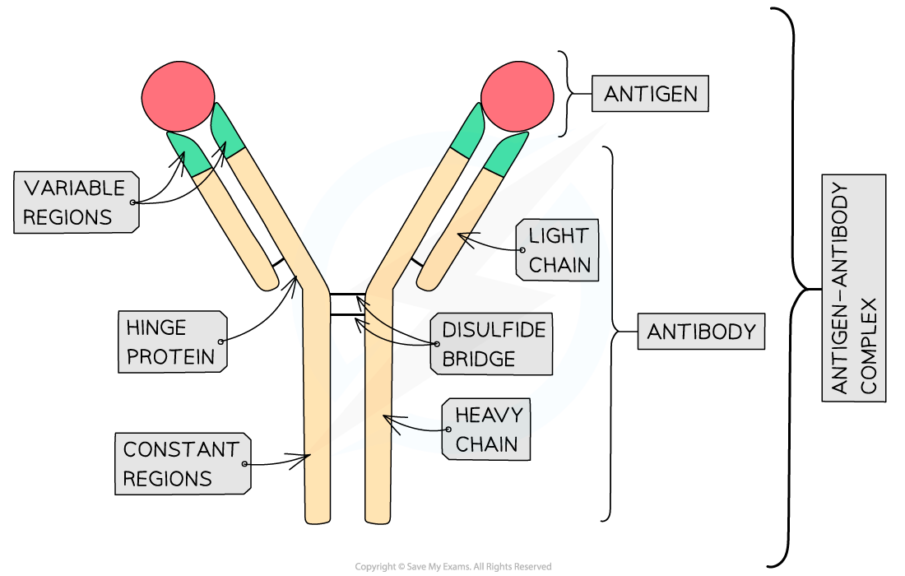
Agglutination process
The process of cross-linking of antigens by antibodies leads to a clumping appearance. This is sometimes also referred to as an agglutination reaction. Agglutination follows the antibody-antigen reaction.
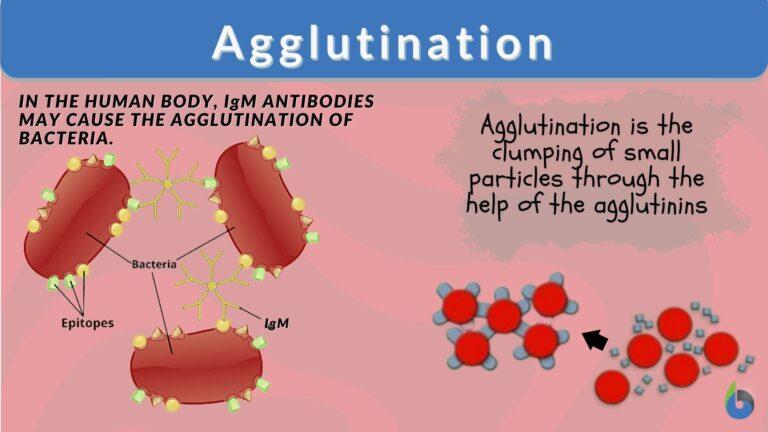
Importance of antibody-antigen reaction
When asked what is the importance of antibody-antigen reaction or what is the purpose of humoral immunity? The answer is: This reaction ensures that the body remains well-protected against the foreign bodies invading the system. By triggering such a reaction every time against a foreign carbohydrate, lipid, or proteinaceous agent, the body builds its immune system stronger.
Complement system
The complement system is responsible for:
- Cell lysis
- Immune clearance
- Opsonization
- Pro-inflammatory effect
They play an indispensable role in the amplification and complementation of antibody action. Through this process, they contribute their share of the humoral immunity.
Complement proteins are mainly produced by hepatocytes. Although some percentage of proteins are also produced by macrophages, adipose tissues, and intestinal epithelial cells.
There are 2 ways by which complement proteins function:
- With antibodies: Classical Pathway
- Without antibodies: Alternate Pathway
The complement system is not only involved in acquired immunity but also in innate immunity.
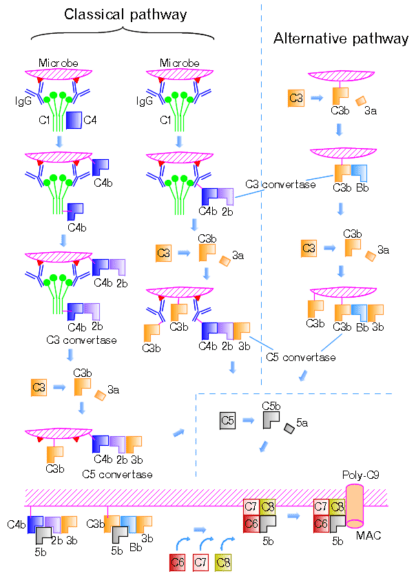
Figure 12: The two different pathways, classical and alternate where the complement system is involved. Image Credit: Tossh_eng.
FAQ
Which cells are involved in humoral immunity?
B cells, T cells, and macrophages
What are the two types of humoral immunity?
The two types of humoral immunity are active and passive immunity. Even active and passive immunities are of two types, natural and artificial.
- Natural active immunity: This immunity is built when antigen naturally enters the body in its wild form. In this type, the immune system is actively involved. Both recognition and memory are built by the immune cell in this type.
- Natural passive immunity: This immunity is the one that is passed from the mother to the fetus through the placenta. No immune system of the fetus is involved. Some of the mother’s antibodies are passed from the mother’s body to the fetus’ body. This is a humoral immunity example via natural passive way.
- Artificial active immunity: This immunity is built when an antigen enters the body in dead or attenuated form via vaccines (humoral immunity vaccines). When dead antigens are introduced, there are no chances of the establishment of disease and the immunity built is ‘limited’ in nature. When attenuated antigens are introduced, there are some chances of the development of virulence.
- Artificial passive immunity: This immunity is one that is acquired through the introduction of exogenous antibodies.
What are the characteristics of humoral immunity?
Important characteristics of humoral immunity are the following:
- Antigen-specific antibody production
- The immunity triggered by B-cells/B-lymphocytes
- Antibody production by plasma B-cells
- Mediation of immunity by B-cells, T-cells, and macrophages
- The main targets of humoral immunity are extraneous or extracellular microbes and their toxins.
- Major antigen-recognizing receptors are BCR receptors (mIgM+mIgD).
- Time of action of humoral immunity is rapid.
Trivia Time: Antibodies in the Human Body
The different types of antibodies work in distinct fashions. Their mechanisms of action, life spans, molecular weights, concentrations, and leakage rates from the mother’s side of the placenta to the fetal side of the placenta are all very different. Let’s put some light on these various factors.
- Decreasing order of ‘concentration’ of different antibodies in body humor:
IgG > IgA > IgM > IgD > IgE - Decreasing order of ‘molecular weight’ of different antibodies in body humor:
IgM > IgA > IgE > IgD > IgG - Decreasing order of ‘life spans’ of different antibodies in body humor:
IgG > IgA > IgM > IgD > IgE - Decreasing order of ‘leakage rate from mother’s to fetal side of placenta’ of IgG subtypes in body humor:
IgG3=IgG1 > IgG4 > IgG2 (Only IgG is able to travel across FCRN, i.e., FC Receptor of neonate) - Mother’s milk is rich in sIgA and sIgG (“s” stands for ‘secretory’)
Answer the quiz below to check what you have learned so far about humoral immunity.
References
- Metchnikoff, Elie (1905) Immunity in infectious disease. Cambridge University Press
MLA style: Paul Ehrlich – Facts. NobelPrize.org. Nobel Prize Outreach AB 2022. Sun. 24 Jul 2022. https://www.nobelprize.org/prizes/medicine/1908/ehrlich/facts/ - Pier GB, Lyczak JB, Wetzler LM (2004). Immunology, Infection, and Immunity. ASM Press. ISBN 9781683672111.
- Goldberg, Richard J. (1952). “A Theory of Antibody—Antigen Reactions. I. Theory for Reactions of Multivalent Antigen with Bivalent and Univalent Antibody”. Journal of the American Chemical Society. 74 (22): 5715–5725. doi:10.1021/ja01142a045
- Janeway CA Jr, Travers P, Walport M, et al. Immunobiology: The Immune System in Health and Disease. 5th edition. New York: Garland Science; 2001. Chapter 9, The Humoral Immune Response. Available from: https://www.ncbi.nlm.nih.gov/books/NBK10752/
- MN Editors. (2022, January 20). Differences between Humoral Immunity and Cell mediated Immunity. Microbiology Note. https://microbiologynote.com/differences-between-humoral-immunity-and-cell-mediated-immunity/
©BiologyOnline.com. Content provided and moderated by Biology Online Editors.

